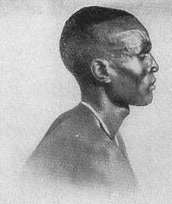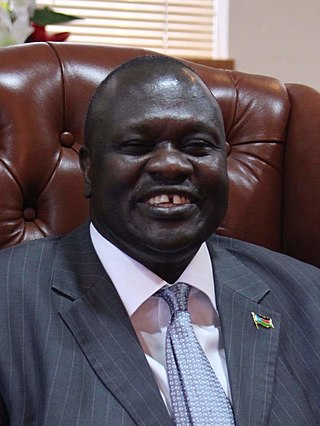Related Research Articles
Dinka spirituality is the traditional religion of the Dinka people, an ethnic group of South Sudan. They belong to the Nilotic peoples, which is a group of cultures in Southern Sudan and wider Eastern Africa. The Dinka people largely rejected or ignored Islamic and Christian teachings, as Abrahamic religious beliefs were incompatible with their society, culture and traditional beliefs.

Jonglei State is a state of South Sudan with Bor as its centre of government and the biggest city. Jonglei state comprises nine counties: Bor, Akobo, Ayod, Uror, Duk, Nyirol, Pigi, Twic East, and Fangak. Jonglei State is the largest state by area before reorganisation, with an area of approximately 122,581 km2, as well as the most populous according to the 2008 census conducted in present-day South Sudan's second period of autonomy. The boundaries of the state were again changed as a result of a peace agreement signed on 22 February 2020.

The Dinka people are a Nilotic ethnic group native to South Sudan. The Dinka mostly live along the Nile, from Mangalla-Bor to Renk, in the region of Bahr el Ghazal, Upper Nile, and the Abyei Area of the Ngok Dinka in South Sudan.

The Nuer people are a Nilotic ethnic group concentrated in the Greater Upper Nile region of South Sudan. They also live in the Ethiopian region of Gambella. The Nuer speak the Nuer language, which belongs to the Nilotic language family. They are the second-largest ethnic group in South Sudan and the largest ethnic group in Gambella, Ethiopia. The Nuer people are pastoralists who herd cattle for a living. Their cattle serve as companions and define their lifestyle. The Nuer call themselves "Naath".

Bor is a historic city in the Bor region of Jonglei State, located in the central region of South Sudan. It has also served as the headquarters of Jonglei state. The city is situated on the east side of the White Nile at the southern extent of the sudd, South Sudan's vast central wetlands.

Riek Machar Teny Dhurgon is a South Sudanese politician who has served as the First Vice President of South Sudan since 2020.
Douglas Hamilton Johnson is an American scholar who lives in Britain who specializes in the history of North East Africa, Sudan and the Southern Sudan.
The Bongo are a Central Sudanic speaking ethnic group, living at the eastern side of the Albert Nile River in northwestern Uganda and in neighbouring South Sudan in small, scattered settlements south and east of Wau. They speak the Bongo language, one of the Bongo-Baka languages. In the early 1990s, their number was estimated at 200.000 people, with 40% Muslims. Unlike the Dinka and other Nilotic ethnic groups, the Bongo are not a cattle herding people and do not use cows for bride price. Subsistence farming and hunting is the primary source of food, though money is obtained by working in forestry, building, selling honey, and other various means. Before imported metalwork became available, they were known for their traditional production of iron tools.
Ayod County {Formerly known as Yod locally } is an administrative area in Jonglei State, South Sudan, with headquarters in Ayod. Its inhabited by Gawaar Nuer categorically divided into two sections e.g Baar and Nyang then which are further consists of major clans of Chieng- Kapel, Bhaang,Jamuogh, Chieng -Thony, Chieng - Nyadakuon, Jithiep, Chieng-Pear, and Chieng-Nyaiguak. In the January 2011 referendum the results were unanimously in favor of independence from Sudan.
Major General Yohannes Yual Both was a leader of the South Sudan Defense Forces whose mobile forces gave the Sudan People's Liberation Army considerable difficulty during the Second Sudanese Civil War (1983–2005).
Ethnic violence in South Sudan has a long history among South Sudan's varied ethnic groups. South Sudan has 64 tribes with the largest being the Dinka, who constitute about 35% of the population and predominate in government. The second largest are the Nuers. Conflict is often aggravated among nomadic groups over the issue of cattle and grazing land and is part of the wider Sudanese nomadic conflicts.

The South Sudanese Civil War was a multi-sided civil war in South Sudan between forces of the government and opposition forces. In December 2013, President Salva Kiir accused his former deputy Riek Machar and 10 others of attempting a coup d'état. Machar denied trying to start a coup and fled to lead the Sudan People's Liberation Movement-in-Opposition (SPLM-IO). Fighting broke out between the Sudan People's Liberation Movement (SPLM) and SPLM-IO, igniting the civil war. Ugandan troops were deployed to fight alongside the South Sudanese government. The United Nations has peacekeepers in the country as part of the United Nations Mission in South Sudan (UNMISS).
Ngundeng Bong was a prophet of the Nuer people of South Sudan believed to having been conceived by his mother Nyayiel Malual through spirit. He presented himself as being an earthly representative of Deng, the sky god of the Nuer religion. His prophecies of the breakup of Sudan are still a factor in the politics of modern South Sudan.
Ngok Lual Yak is an African sub-tribe, within the Jiëŋ (Dinka) group. They are mainly found in Malakal, South Sudan and inhabit the land along the confluences of the Nile and Sobat rivers. It is believed that the sub-tribe numbers about 95,000. They are devoted ethnics and believe in Deŋdit as their provider. Some of Ngok sections are part of Bor Community and sections who identifies themselves as descendants of Ngok could still be traced!
Nyaruac Kolang was a Nuer prophetess.
Nhialic is the supreme creator god of the Dinka pantheon, whose people now dwell in South Sudan. When used in the context of Dinka language, the term also can refer to the entirety of the gods within the Dinka pantheon. In some accounts, Nhialic is also known as Deng Dit.

Nuerland is the indigenous homeland and traditional territory of the Nuer people, situated largely within South Sudan between the latitudes of 7° and 10° north and longitudes of 29° and 32° east. The region encompasses parts of the Upper Nile State, Jonglei State, Unity State, and surrounding areas, characterized by a mix of swamps, savannahs, and higher ground.

Ngundeng Pyramid, also known as Pyramid of Dengkur, was a large mound shrine constructed by the Nuer people's prophet Ngundeng Bong at the end of the nineteenth century and added to by his son Guek Ngundeng. The Ngundeng Pyramid, which was around 300 feet in circumference and 50 to 60 feet tall, cone-shaped, and encircled by a row of elephant tusks, was a symbol of the Nuer people's resistance to colonialism. The monument was dynamited on the orders of British colonial commander Percy Coriat in 1928, shortly after the first attempt to demolish it failed.

Percy Coriat (1898–1960) was a British colonial officer in Anglo-Egyptian Sudan, an administrator among the Nuer, and, the first British official who became fully conversant in Nuer Language.
Deng Laka was a Gaawar Nuer people's prophet of the divinity DIU. He led the Nuer in the battle called Mut Roal against the Twic Dinka and their Arab allies in which the Nuer emerged victorious. He also led the force that overthrew Nuaar Mer in 1879, the merchant's ally among Gaawar.
References
- 1 2 "Short Biography of Guek Ngundeng Bong (Sept 1890 – Feb 1929) - Lich Research Institute". 2022-12-22. Retrieved 2024-06-26.
- ↑ "Sudan Notes and Records Volume 22 — Sudan Open Archive". sudanarchive.net. Retrieved 2024-06-26.
- ↑ Murdoch, Brian (April 1995). "Governing the Nuer: Documents by Percy Coriat on Nuer History and Ethnography 1922–1931". African Affairs. 94 (375): 298–299. doi:10.1093/oxfordjournals.afraf.a098821. ISSN 1468-2621.
- ↑ "Prophecy: African Prophetism | Encyclopedia.com". www.encyclopedia.com. Retrieved 2024-07-15.
- ↑ Coriat, P. (1939). "Gwek, the Witch-Doctor and the Pyramid of Denkgur". Sudan Notes and Records. 22 (2): 221–237. ISSN 0375-2984. JSTOR 41716333.
- 1 2 Coriat, P. (1939). "Gwek, the Witch-Doctor and the Pyramid of Denkgur". Sudan Notes and Records. 22 (2): 221–237. ISSN 0375-2984. JSTOR 41716333.
- ↑ "Prophecy: African Prophetism | Encyclopedia.com". www.encyclopedia.com. Retrieved 2024-06-30.
- 1 2 ADMINROOT (2022-07-14). "Epistemicide, Historicide and Ethnocide: Cases for the Restitution of the Artefacts of African Knowledge. By Harry Wilson Kapatika". roots§routes. Retrieved 2024-06-30.
- ↑ johnson, douglas h johnsondouglas h (2011-01-01), Akyeampong, Emmanuel K.; Gates, Henry Louis (eds.), "Ngundeng Bong", Dictionary of African Biography, Oxford University Press, doi:10.1093/acref/9780195382075.001.0001, ISBN 978-0-19-538207-5 , retrieved 2024-06-30
- 1 2 Johnson, Douglas H. (1994). "Nuer Prophets: A History Of Prophecy From The Upper Nile In The Nineteenth And Twentieth Centuries | Oxford Academic". academic.oup.com. doi:10.1093/oso/9780198279075.001.0001. ISBN 978-0-19-827907-5 . Retrieved 2024-06-30.
- 1 2 Johnson, Douglas H. (1979). "Colonial Policy and Prophets: The 'Nuer Settlement'". Journal of the Anthropological Society of Oxford. 10 (1): 1–20.
- ↑ ""As imposing a show as possible": Aviation in colonial Sudan and South Sudan, 1916-1930". Juba in the Making. 2019-10-04. Retrieved 2024-06-30.
This article needs additional or more specific categories .(October 2024) |